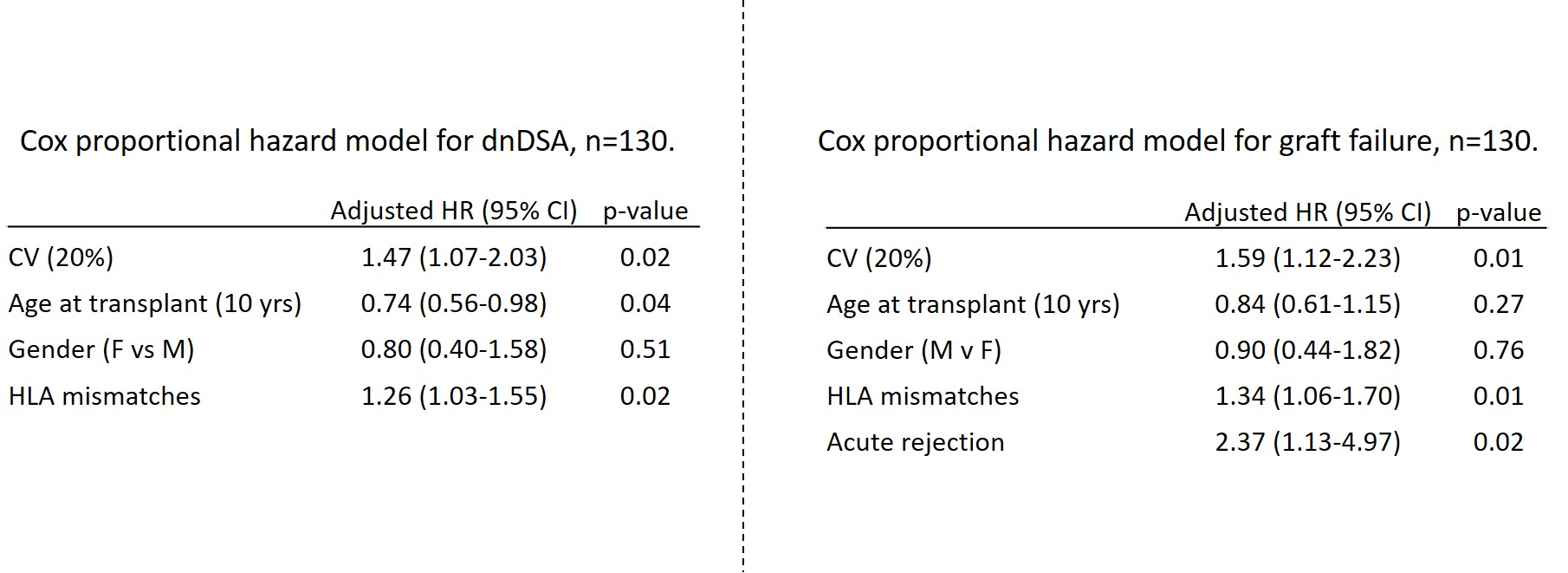Association of Tacrolimus-Level Variance with De Novo DSA within the First 2 Years after Renal Transplantation
1Terasaki Research Institute, Los Angeles, CA, 2East Carolina University, Greenville, NC, 3Eastern Nephrology Associates, Greenville, NC, 4Vidant Medical Center, Greenville, NC
Meeting: 2019 American Transplant Congress
Abstract number: 398
Keywords: Pharmacokinetics
Session Information
Session Name: Concurrent Session: Non-Organ Specific: Pharmacogenomics / Pharmacokinetics
Session Type: Concurrent Session
Date: Monday, June 3, 2019
Session Time: 4:30pm-6:00pm
 Presentation Time: 5:30pm-5:42pm
Presentation Time: 5:30pm-5:42pm
Location: Room 210
*Purpose: Patients that receive an HLA-mismatched kidney transplant (KT) have an increased likelihood to develop de novo DSA (dnDSA). Ideally, immunosuppression is properly adjusted and maintained to decrease risk of rejection, dnDSA and graft loss. Our analysis investigated the association between variance (i.e. erratic) of tacrolimus levels and dnDSA development.
*Methods: A single-center cohort of 130 KT recipients (transplanted from 1/2010 thru 8/2011) were analyzed. Patient were not included in the analysis if DSA was preformed or first appeared prior to the 3rd month post-transplant. Development of dnDSA was measured using single antigen beads (One Lambda, CA) at 1, 3, 6, and 12 months then biannually. dnDSA was considered positive if the MFI was ≥1000. All dnDSA was in the first 2 years post-transplant. All patients had at least 3 tacrolimus levels between 3-18 months post-transplant. Tacrolimus coefficient of variation (CV) for each patient was determined by the following calculation: (standard deviation / mean of tacrolimus levels) x 100.
*Results: Within the 130 KT patients, 36 developed dnDSA at a median of 10.8 months post-KT. Investigating variables by Cox regression analysis, tacrolimus CV (HR per 20% increase 1.47, 95% CI 1.07-2.03, p=0.02) and total number of HLA mismatches (HR 1.26, 95% CI 1.03-1.55, p=0.02) were significantly associated with dnDSA, after controlling for recipient age at KT and gender in the model. Variables associated with graft failure by Cox regression analysis were every 20% increase in tacrolimus CV (HR 1.59, 95% CI 1.12-2.23, p=0.01), total number of HLA mismatches (HR 1.34, 95% CI 1.06-1.70, p=0.01) and acute rejection (HR 2.37, 95% CI 1.13-4.97, p=0.02) – after controlling for recipient age at KT and gender in the model. This indicates that for every 20% increase in tacrolimus CV in the first 18 months post-KT, patients are 59% more likely to experience graft failure.
*Conclusions: From this study, we have shown that post-KT erratic tacrolimus levels is associated with the development of dnDSA. Further analysis will be conducted to determine if tacrolimus CV can be used in a model to predict dnDSA.
To cite this abstract in AMA style:
Everly MJ, Purnajo I, Briley KP, Beaumont JL, Bolin P, Kendrick SA, Jones H, McLawhorn K, Maldonado AQ, Leeser D, Haisch CE, Rebellato LM. Association of Tacrolimus-Level Variance with De Novo DSA within the First 2 Years after Renal Transplantation [abstract]. Am J Transplant. 2019; 19 (suppl 3). https://atcmeetingabstracts.com/abstract/association-of-tacrolimus-level-variance-with-de-novo-dsa-within-the-first-2-years-after-renal-transplantation/. Accessed December 9, 2025.« Back to 2019 American Transplant Congress

